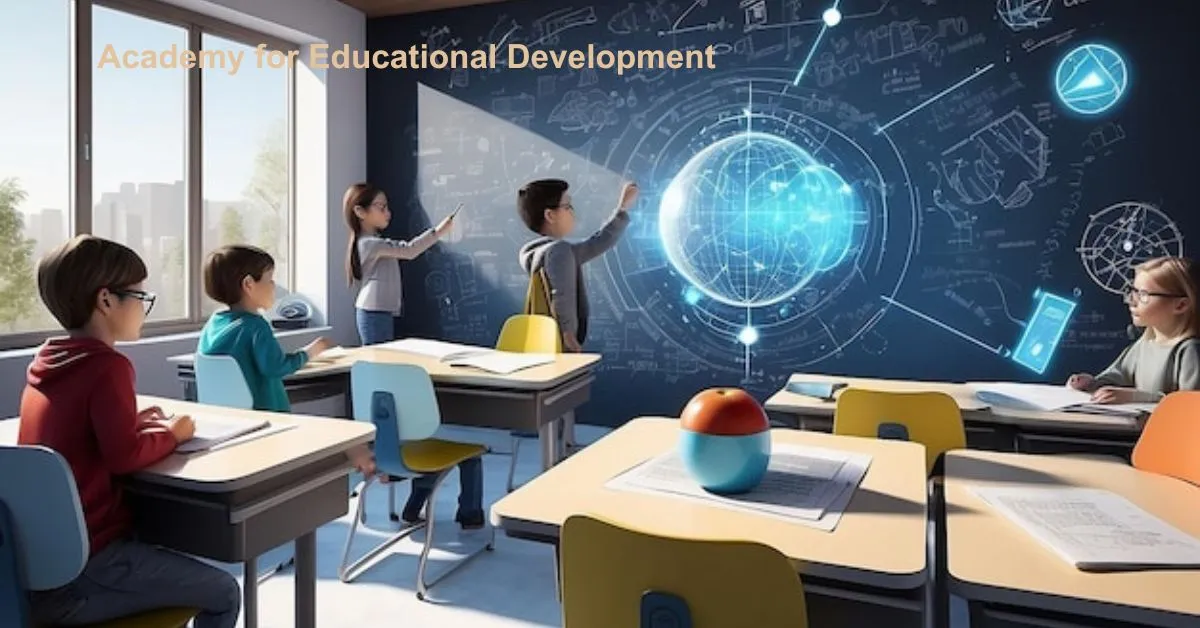Education
Academy for Educational Development: Teaching for a Better Future

Education is the foundation of any progressive society, serving as the backbone for future growth and development. But what exactly constitutes educational development, and why is it so vital? Academy for Educational Development involves the improvement of teaching methods, curriculum design, and learning environments to enhance educational outcomes. It’s the process of making education more effective, accessible, and equitable for all.
What is an Academy for Educational Development?
An Academy for Educational Development (AED) is a specialized institution focused on advancing educational practices through research, training, and innovation. These academies aim to improve the quality of education by developing new teaching strategies, creating effective curricula, and fostering an environment conducive to learning. The ultimate goal is to ensure that educators are well-equipped to meet the diverse needs of their students and to help students reach their full potential.
History and Evolution
Early Beginnings
The concept of educational development has been around for centuries, evolving significantly over time. Initially, it involved basic teacher training and curriculum development. However, as educational needs grew more complex, the focus expanded to include various aspects of teaching and learning, such as technology integration and student engagement.
Significant Milestones
Over the years, many significant milestones have marked the evolution of educational development. These include the establishment of dedicated educational development institutions, the integration of technology into classrooms, and the development of comprehensive training programs for educators. Each of these milestones has contributed to making education more effective and inclusive.
Key Components of Educational Development
Curriculum Design
One of the critical components of educational development is curriculum design. This involves creating a structured plan of what will be taught and how it will be delivered. A well-designed curriculum ensures that all students have access to the necessary knowledge and skills they need to succeed.
Teacher Training
Effective educational development cannot occur without proper teacher training. This involves equipping teachers with the skills and knowledge they need to deliver high-quality education. Training programs often include workshops, certification courses, and continuous professional development opportunities.
Student Engagement
Engaging students in the learning process is another essential component. This involves using various techniques and strategies to make learning more interesting and interactive. When students are engaged, they are more likely to retain information and perform better academically.
Technology Integration
In today’s digital age, integrating technology into the classroom is crucial. This includes using digital tools and resources to enhance teaching and learning. Technology can provide students with access to a wealth of information and can make learning more interactive and engaging.
Benefits of an Academy for Educational Development
Improved Teaching Standards
One of the primary benefits of an AED is the improvement of teaching standards. By providing educators with the necessary training and resources, these academies ensure that teachers are well-prepared to deliver high-quality education.
Enhanced Student Learning Outcomes
When teaching standards improve, so do student learning outcomes. AEDs help create an environment where students can thrive academically, leading to better grades, higher test scores, and improved overall academic performance.
Professional Growth for Educators
AEDs also contribute to the professional growth of educators. By participating in training programs and workshops, teachers can enhance their skills and advance their careers. This not only benefits the teachers themselves but also the students they teach.
Community Impact
Improving education has a ripple effect on the community. When students receive a quality education, they are more likely to become productive members of society. This, in turn, can lead to economic growth and a more vibrant community.
Challenges Faced by Educational Development Academies
Funding Issues
One of the significant challenges AEDs face is securing adequate funding. Education is often underfunded, and without sufficient financial resources, it can be challenging to implement effective programs and initiatives.
Policy and Regulation Hurdles
Educational policies and regulations can also pose challenges. Navigating these can be complex and time-consuming, and they can sometimes hinder the implementation of innovative educational practices.
Adapting to Technological Changes
With technology constantly evolving, keeping up with the latest advancements can be a challenge. AEDs must continually adapt their practices to incorporate new technologies effectively.
Successful Models Around the World
Case Study: Finland
Finland is renowned for its exceptional educational system. The country places a strong emphasis on teacher training and student well-being, resulting in high student performance and satisfaction.
Case Study: Singapore
Singapore’s education system is another successful model. The country focuses on rigorous teacher training and a well-rounded curriculum, which has led to excellent academic outcomes.
Case Study: United States
In the United States, various AEDs have implemented innovative programs to improve education. These include incorporating technology into the classroom and developing comprehensive teacher training programs.
Implementing Effective Strategies
Needs Assessment
Before implementing any educational development initiatives, it’s crucial to conduct a needs assessment. This involves identifying the specific needs and challenges of the educational system and developing strategies to address them.
Collaborative Approaches
Collaboration is key to successful educational development. This includes working with teachers, students, parents, and the community to create a supportive learning environment.
Continuous Professional Development
Continuous professional development is essential for educators. This involves providing ongoing training and development opportunities to ensure that teachers can keep up with the latest educational practices and technologies.
Role of Technology in Educational Development
Digital Classrooms
Digital classrooms are becoming increasingly popular in today’s educational landscape. These classrooms use digital tools and resources to enhance teaching and learning, making education more interactive and engaging.
E-Learning Platforms
E-learning platforms provide students with access to educational resources anytime, anywhere. These platforms can be particularly beneficial for students who need additional support or who are unable to attend traditional classes.
Data-Driven Decision Making
Using data to inform decision-making is another important aspect of educational development. This involves collecting and analyzing data on student performance to identify areas for improvement and to develop effective strategies.
Training Programs and Workshops
Teacher Certification Programs
Teacher certification programs are essential for ensuring that educators have the necessary skills and knowledge. These programs provide comprehensive training and are often required for teachers to work in specific educational settings.
Leadership Training
Leadership training is also crucial for educational development. This involves training school leaders and administrators to effectively manage and support their staff and students.
Student Development Workshops
Student development workshops provide students with additional support and resources. These workshops can cover various topics, such as study skills, time management, and career planning.
Community and Parental Involvement
Importance of Community Engagement
Engaging the community is essential for successful educational development. When the community is involved, it creates a supportive environment for students and can lead to better educational outcomes.
Strategies for Parental Involvement
Parental involvement is also crucial. This includes encouraging parents to participate in school activities, communicate regularly with teachers, and support their children’s learning at home.
Policy Recommendations
Government Support
Government support is vital for educational development. This includes providing adequate funding, developing supportive policies, and ensuring that all students have access to quality education.
Private Sector Involvement
The private sector can also play a role in educational development. This includes providing funding and resources, as well as collaborating with educational institutions to develop innovative programs.
International Collaboration
International collaboration can help share best practices and develop effective educational strategies. This involves working with educational institutions and organizations from around the world to improve education globally.
Future Trends in Educational Development
Artificial Intelligence
Artificial intelligence (AI) is set to play a significant role in the future of education. AI can provide personalized learning experiences, automate administrative tasks, and analyze student performance data to identify areas for improvement.
Personalized Learning
Personalized learning is another emerging trend. This involves tailoring education to meet the individual needs and preferences of each student, ensuring that they receive the support and resources they need to succeed.
Global Education Networks
Global education networks are also becoming increasingly important. These networks connect educators and students from around the world, providing access to a wealth of resources and fostering collaboration.
Conclusion
Academies for educational development play a crucial role in improving the quality of education. By focusing on curriculum design, teacher training, student engagement, and technology integration, these academies help ensure that all students receive a high-quality education. Despite the challenges they face, such as funding issues and policy hurdles, AEDs continue to make significant strides in advancing education. Looking ahead, the future of educational development is bright, with emerging trends like AI and personalized learning set to revolutionize the way we educate our students.
FAQs
What is the main goal of an Academy for Educational Development?
The main goal of an AED is to improve the quality of education by developing effective teaching strategies, creating comprehensive curricula, and fostering an environment conducive to learning.
How can parents contribute to educational development?
Parents can contribute by participating in school activities, communicating regularly with teachers, and supporting their children’s learning at home.
What role does technology play in modern educational development?
Technology enhances teaching and learning by providing digital tools and resources, enabling e-learning, and facilitating data-driven decision-making.
Why is teacher training crucial for educational development?
Teacher training is crucial because it equips educators with the skills and knowledge they need to deliver high-quality education and support their students effectively.
How do academies for educational development impact communities?
AEDs impact communities by improving educational outcomes, leading to a more educated and productive population, which can drive economic growth and enhance community well-being.
Education
Clark County Education Association: Empowering Education in Southern Nevada

Organisations like the Clark County Education Association (CCEA) play a crucial role in assuring the quality of education in Southern Nevada, because education is the cornerstone of any society’s growth. In this piece, we’ll examine the background, achievements, and influence of CCEA in the area.
Understanding Clark County Education Association (CCEA)
The Clark County Educators’ Association (CCEA) is a highly visible advocacy group for Clark County, Nevada’s educators, instructors, and educational support workers. It is a nonprofit organisation whose mission is to promote excellence in education and to assist those who work in the field.
History of CCEA
CCEA has a long history of advocating for educational concerns in Southern Nevada. It was set up so that local teachers could communicate with one another and pool their resources to better serve their students.
CCEA’s Mission and Goals
CCEA’s goal is to provide every Clark County student with an excellent education and to equip every educator with the tools they need to succeed. Professional growth, improved working conditions, and more involvement in the local community are all priorities for them.
The Role of CCEA in Education
CCEA is vital to education in many ways. It fights for teachers’ rights to earn a living wage and works to improve their working conditions in order to benefit their pupils. In addition, the group offers helpful materials for teachers.
Benefits of CCEA Membership
Educators can benefit in many ways by joining CCEA. As a member, you’ll have the chance to network with other educators and further your career, as well as receive legal representation if you need it. CCEA gives its members the tools they need to be successful teachers.
Challenges Faced by CCEA
CCEA, like any other organisation, confronts obstacles on its path to achieving its goal of enhancing education. CCEA is dedicated to its mission regardless of funding concerns, governmental shifts, or social obstacles.
CCEA’s Impact on the Community
CCEA does not limit itself to the confines of the classroom. As a result of their hard work, the local community benefits from an improved and more well-educated populace.
Advocacy Efforts by CCEA
CCEA fights tirelessly for measures that improve education for teachers and their students. To spread word of their cause, they organise lobbying efforts, grass-roots campaigns, and public awareness campaigns.
Collaborations and Partnerships
To accomplish its objectives, CCEA partners with several educational institutions, government agencies, and community groups. Their combined efforts will have a greater impact.
The Future of CCEA
CCEA is committed to continuing to shape the educational environment of Southern Nevada as it evolves. Because of their flexibility and perseverance, they will continue to be an influential group in the field of education.
How to Join CCEA
CCEA has a simple membership process for educators who desire to become a part of this influential organisation. By joining, you’ll be connected to a group of educators who share your passion for the profession and are committed to its improvement.
Success Stories and Testimonials
Learn directly how CCEA’s efforts have impacted the lives and careers of educators from those in the field. Their experiences highlight the significance and commitment of the group.
Conclusion
Educators and students in Southern Nevada have a ray of light in the form of the Clark County Education Association. The significance of this organisation is demonstrated by its dedication to high standards in education, advocacy, and community service. Participate in the improvement of Clark County’s educational system by joining CCEA.
FAQs
1. How can I join CCEA?
Joining CCEA is easy. Visit their official website and follow the membership instructions to become a member.
2. What benefits do CCEA members receive?
CCEA members enjoy professional development opportunities, legal support, and a supportive community of educators.
3. Does CCEA only focus on teachers, or do they support all educational professionals?
CCEA represents the interests of all educators, including teachers and educational support professionals.
4. How can I support CCEA’s advocacy efforts?
You can support CCEA by staying informed about their initiatives, participating in their campaigns, and spreading awareness about the importance of quality education.
5. What is CCEA’s vision for the future of education in Southern Nevada?
CCEA aims to continue shaping the future of education by adapting to changing needs and advocating for policies that benefit educators and students.
Education
15 cm to Inches how to Convert: The Art of Centimeter to Inch Conversion

15 cm to Inches, everyday life presents us with several opportunities to do unit conversions. Unit conversions are useful for many different reasons, including home repair projects and schoolwork. In this post, we will learn how to convert 15 cm to Inches, as well as discuss the relevance of this and other frequent conversions.
What is the Conversion Factor?
Knowing how many centimetres equal how many inches is necessary background reading. There are exactly 2.54 centimetres in one inch. All conversions from centimetres to inches use this factor.
How to Convert Centimeters to Inches
The procedure of converting centimetres to inches is simple. The following formula may be used to convert any length expressed in centimetres to inches:
Length (in inches) = Length (in centimeters) / 2.54
The Formula for Converting cm to inches
Let’s break down the formula. To convert 15 cm to Inches , you would divide 15 by 2.54:
So, 15 centimeters is approximately equal to 5.91 inches.
Why Do We Need to Convert These Units?
Converting from centimetres to inches may seem pointless at first. The context usually dictates whether one uses centimetres or inches. Some regions of the globe more widely use the metric system, which includes centimeters, while others commonly use the imperial system, which includes inches. Fluency in both systems is required for effective international interaction across cultural boundaries.
Practical Applications
There are many real-world uses for knowing how to convert centimetres to inches. It’s crucial for global commerce, as both metric and imperial measurements of products are required. In addition, it finds use in industries including building, decorating, and tailoring, all of which depend on accurate sizing.
Similar Conversions
To convert between any two lengths, all you need to know is the conversion factor of 2.54. Divide millimetres by 25.4 to get inches, and multiply feet by 0.3048 to get metres.
Historical Perspective
There’s a lot of interesting backstory behind these squads. While the Romans introduced the inch to the metric system, the centimetre was introduced much later. A greater appreciation for these measures is possible with knowledge of their historical setting.
Fun Facts About Inches
Did you know that internationally, one inch is equivalent to exactly 2.54 centimetres? It is one of the few units with a well-defined metric system.
The Importance of Accuracy
It is crucial to be precise while taking measurements, as even a slight deviation might have major consequences. When dealing with lengths, be sure to always use the appropriate unit and do proper conversions.
Tools for Conversion
There are a number of convenient centimeter-to-inch conversion tools available. The precision of your measurements may be improved by using tools like rulers, calculators, and even applications on your smartphone.
Online Conversion Calculators
Now that we live in the digital era, conversion calculators are easily accessible online. Converting centimetres to inches is a breeze with the help of online tools or mobile apps.
Common Mistakes to Avoid
It’s easy to make a mistake while converting units, such as by applying the incorrect conversion factor or by rounding off too soon. Always round off your final answer, not your calculations, to the exact factor of 2.54.
Conclusion
Converting 15 cm to Inches is a useful ability, and knowing the conversion factor between the two units is even better. Knowing how to convert units helps bridge the gap between different measuring systems, which is useful whether you’re travelling, working on a project, or just inquisitive about the world around you. Therefore, you will be prepared to deal with a unit conversion the next time you come across one.
FAQs
- Is 2.54 the only conversion factor between centimeters and inches?
No, 2.54 is the standard conversion factor. However, for precise conversions, it’s always best to use this exact figure. - Why do some countries prefer inches over centimeters?
Historical and cultural factors play a role in the choice of units. Some countries have a tradition of using the imperial system, which includes inches. - Are there any industries where centimeters are more commonly used than inches?
Yes, the metric system, including centimeters, is the primary system used in scientific research, engineering, and healthcare. - Can I use approximate conversions in everyday situations?
While approximate conversions may be acceptable for casual use, precision is crucial in fields like science, engineering, and construction. - Are there any other units that use the 2.54 conversion factor?
Yes, the same factor is used when converting millimeters to inches, making it a versatile tool for various length measurements.
READ MORE
Education
410 Inches: From Nature’s Wonders to Technological Marvels

At first glance, the number 410 inches may seem arbitrary or inconsequential, but upon closer inspection, it reveals itself to be a measurement of considerable significance. In this article, we will delve into the myriad contexts in which the measurement of 410 inches holds importance, from the natural world to the realm of technology and beyond. Join us on a journey of exploration as we uncover the magnitude and implications of 410 inches.
Nature’s Wonders: 410 Inches in the Wilderness
In the realm of nature, 410 inches can represent the height of majestic trees, the length of awe-inspiring waterfalls, or the span of magnificent geological formations. Consider, for example, the towering sequoias of California’s Sierra Nevada, some of which reach heights exceeding 410 inches, making them among the tallest living organisms on Earth. These ancient giants serve as a testament to the resilience and grandeur of nature, inspiring awe and reverence in all who behold them.
Alternatively, 410 inches could denote the length of a mighty waterfall, cascading down rocky cliffs with breathtaking force and beauty. Whether it’s the iconic Niagara Falls or the majestic Angel Falls in Venezuela, waterfalls measuring 410 inches or more captivate the imagination and draw visitors from around the world to witness their splendor firsthand.
In the realm of geology, 410 inches might signify the span of a massive rock formation, such as the towering cliffs of the Grand Canyon or the imposing granite monoliths of Yosemite National Park. These geological wonders stand as enduring testaments to the forces of erosion and uplift that have shaped the Earth’s surface over millions of years, offering a glimpse into the planet’s tumultuous past.
Architectural Marvels: 410 Inches in Construction
In the world of architecture and construction, 410 inches can represent the height of skyscrapers, the length of bridges, or the span of expansive structures. Imagine, for instance, the towering spires of the world’s tallest buildings, reaching heights of 410 inches or more and piercing the sky with their sleek, modern designs. From the Burj Khalifa in Dubai to the Shanghai Tower in China, these architectural marvels stand as symbols of human ingenuity and ambition, pushing the limits of what is possible in the realm of construction.
Alternatively, 410 inches might denote the length of a sprawling bridge, spanning rivers, bays, or canyons with graceful arches or sturdy trusses. Bridges such as the Golden Gate Bridge in San Francisco or the Akashi Kaikyō Bridge in Japan demonstrate the engineering prowess required to construct such monumental structures, facilitating transportation and commerce while serving as iconic landmarks in their own right.
In the realm of infrastructure, it could signify the span of a massive dam, harnessing the power of rivers and streams to generate electricity, control flooding, and provide water for irrigation and consumption. Dams such as the Hoover Dam in the United States or the Three Gorges Dam in China represent feats of engineering on an epic scale, reshaping landscapes and transforming the flow of rivers to meet the needs of growing populations.
Technological Advancements: 410 Inches in Innovation
In the realm of technology, it can represent the size of cutting-edge displays, the capacity of high-performance hard drives, or the reach of advanced communication networks. Consider, for example, the expansive screens of modern televisions and monitors, measuring it or more diagonally and providing viewers with immersive experiences that rival those of movie theaters and concert halls. These high-definition displays leverage the latest in display technology to deliver stunning visuals and lifelike images, blurring the lines between reality and virtuality.
Alternatively, 410 inches might denote the storage capacity of state-of-the-art hard drives, capable of storing vast amounts of data in compact, portable form factors. Whether it’s for personal use or enterprise applications, these high-capacity drives enable users to store, access, and share large volumes of digital content with ease, fueling the growth of cloud computing, big data analytics, and other data-intensive technologies.
In the realm of telecommunications, it could signify the reach of advanced communication networks, spanning continents and oceans to connect people and devices in real-time. From fiber optic cables that transmit data at the speed of light to satellite networks that provide global coverage, these communication infrastructures enable instant communication and collaboration on a scale never before imagined, revolutionizing how we work, play, and connect with one another.
Conclusion: The Significance of 410 Inches
The measurement of 410 inches holds considerable significance across a wide range of contexts, from the natural world to the realms of construction, technology, and beyond. Whether it’s the height of towering trees, the span of majestic waterfalls, the height of skyscrapers, the length of expansive bridges, the capacity of high-performance hard drives, or the reach of advanced communication networks, 410 inches serves as a reminder of the magnitude and complexity of the world in which we live.
As we continue to push the boundaries of what is possible in the realms of science, engineering, and innovation, it is certain that the significance of will only continue to grow, serving as a benchmark for achievement and a symbol of human ingenuity and ambition. So, the next time you encounter the measurement of 410 inches, take a moment to appreciate the magnitude of its significance and the myriad wonders it represents.
-

 Technology7 months ago
Technology7 months ago社工库: Navigating the Depths of Social Engineering Databases
-

 News5 months ago
News5 months agoFinding the Truth Behind a Trails Carolina Death
-

 Education6 months ago
Education6 months agoFortiOS 7.2 – NSE4_FGT-7.2 Free Exam Questions [2023]
-

 Technology2 months ago
Technology2 months agoAmazon’s GPT-55X: A Revolutionary Leap in AI Technology
-

 Education7 months ago
Education7 months agoExploring the Significance of 92career
-

 News7 months ago
News7 months agoClaudia Goldin: A Trailblazer in Understanding Gender Pay Gap
-

 History & Tradition8 months ago
History & Tradition8 months agoλιβαισ: Unraveling Its Mystique
-

 Entertainment6 months ago
Entertainment6 months agoFree Tube Spot: Your Gateway to Endless Entertainment












